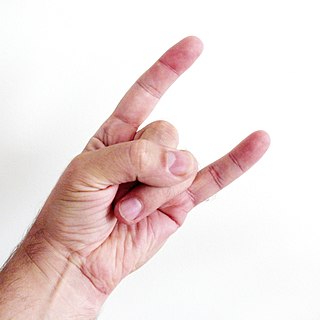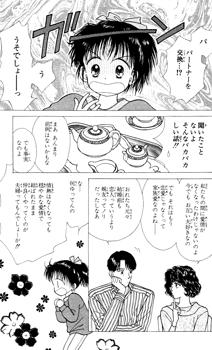Related Research Articles

The evil eye is a supernatural belief in a curse brought about by a malevolent glare, usually inspired by envy. The belief in the evil eye among humans has existed since prehistory, and amulets to protect against it have been found dating to around 5,000 years ago.

Body language is a type of nonverbal communication in which physical behaviors, as opposed to words, are used to express or convey information. Such behavior includes facial expressions, body posture, gestures, eye movement, touch and the use of space. Although body language is an important part of communication, most of it happens without conscious awareness. In social communication, body language often complements verbal communication.

A wink is a facial expression made by briefly closing one eye. A wink is an informal mode of non-verbal communication usually signaling shared hidden knowledge or intent. However, it is ambiguous by itself and highly dependent upon additional context, without which a wink could become misinterpreted or even nonsensical. For example, in some regions of the world, a wink may be considered rude or offensive. Depending on the relationship of the people involved, a wink could possibly constitute a sexual gesture.

Nonverbal communication is the transmission of messages or signals through a nonverbal platform such as eye contact (oculesics), body language (kinesics), social distance (proxemics), touch (haptics), voice (paralanguage), physical environments/appearance, and use of objects. When communicating, we utilize nonverbal channels as means to convey different messages or signals, whereas others can interpret these message. The study of nonverbal communication started in 1872 with the publication of The Expression of the Emotions in Man and Animals by Charles Darwin. Darwin began to study nonverbal communication as he noticed the interactions between animals such as lions, tigers, dogs etc. and realized they also communicated by gestures and expressions. For the first time, nonverbal communication was studied and its relevance questioned. Today, scholars argue that nonverbal communication can convey more meaning than verbal communication.
Silent treatment is the refusal to communicate verbally or electronically with someone who is trying to communicate and elicit a response. It may range from just sulking to malevolent abusive controlling behaviour. It may be a passive-aggressive form of emotional abuse in which displeasure, disapproval and contempt is exhibited through nonverbal gestures while maintaining verbal silence. Clinical psychologist Harriet Braiker identifies it as a form of manipulative punishment. It may be used as a form of social rejection; according to the social psychologist Kipling Williams, it is the most common form of ostracism.

Dog communication is the transfer of information between dogs, as well as between dogs and humans. Behaviors associated with dog communication are categorized into visual and vocal. Visual communication includes mouth shape and head position, licking and sniffing, ear and tail positioning, eye gaze, facial expression, and body posture. Dog vocalizations, or auditory communication, can include barks, growls, howls, whines and whimpers, screams, pants and sighs. Dogs also communicate via gustatory communication, utilizing scent and pheromones.

The sign of the horns is a hand gesture with a variety of meanings and uses in various cultures. It is formed by extending the index and little fingers while holding the middle and ring fingers down with the thumb.

Oculesics, a subcategory of kinesics, is the study of eye movement, behavior, gaze, and eye-related nonverbal communication. The term's specific designation slightly varies apropos of the field of study. Communication scholars use the term "oculesics" to refer to the investigation of culturally-fluctuating propensities and appreciations of visual attention, gaze and other implicitly effusive elements of the eyes. Comparatively, medical professionals may ascribe the same appellation to the measurement of a patient's ocular faculty, especially subsequent a cerebral or other injury.

A taunt is a battle cry, sarcastic remark, gesture, or insult intended to demoralize or antagonize the recipient. Taunting can exist as a form of social competition to gain control of the target's cultural capital. In sociological theory, the control of the three social capitals is used to produce an advantage in the social hierarchy, to enforce one's position in relation to others. This can also be used as a tactic to gain advantage of their opponent's irrational reaction. Taunting is committed by either directly or indirectly encouraging others to taunt the target. The target may give a response in kind to maintain status, as in fighting words and trash-talk.

A mountza or moutza also called faskeloma is the most traditional gesture of insult among Greeks. It consists of extending and spreading all fingers of the hand and presenting the palm towards the face of the person to be insulted with a forward motion.

Japanese manga has developed a visual language or iconography for expressing emotion and other internal character states. This drawing style has also migrated into anime, as many manga stories are adapted into television shows and films.

A facepalm is the physical gesture of placing one's hand across one's face, lowering one's face into one's hand or hands or covering or closing one's eyes. The gesture is often exaggerated by giving the motion more force and making a slapping noise when the hand comes in contact with the face. The gesture is found in many cultures as a display of frustration, disappointment, exasperation, embarrassment, horror, shock, surprise, exhaustion, sarcasm, shame, or incredulous disbelief.
Display rules are a social group or culture's informal norms that distinguish how one should express oneself. They function as a way to maintain the social order of a given culture, creating an expected standard of behaviour to guide people in their interactions. Display rules can help to decrease situational ambiguity, help individuals to be accepted by their social groups, and can help groups to increase their group efficacy. They can be described as culturally prescribed rules that people learn early on in their lives by interactions and socializations with other people. Members of a social group learn these cultural standards at a young age which determine when one would express certain emotions, where and to what extent.

The fig sign is a mildly obscene gesture that uses a thumb wedged in between two fingers. The gesture is most commonly used to ward off the evil eye, insult someone, or deny a request. It has been used at least since the Roman Age in Southern Europe and parts of the Mediterranean region, including in Turkish culture. Some countries in Asia, Slavic cultures and South Africa use it too. It is used playfully in Northwestern Europe and North Africa, countries such as the US, Canada, Australia, Libya, Tunisia and Czech Republic to pretend to take the nose off a child.
An obscene gesture is a movement or position of the body, especially of the hands or arms, that is considered exceedingly offensive or vulgar in some particular cultures. Such gestures are often sexually suggestive.
Body-to-body communication is a way of communicating with others through the use of nonverbal communication, without using speech or verbalization. It can include body language, facial expressions, and other bodily gestures in order to communicate with others without the need of verbal communication. Body-to-body communication accounts for postures, body language, physical touch, nonverbal language, and other bodily gestures.

Looking is the act of intentionally focusing visual perception on someone or something, for the purpose of obtaining information, and possibly to convey interest or another sentiment. A large number of troponyms exist to describe variations of looking at things, with prominent examples including the verbs "stare, gaze, gape, gawp, gawk, goggle, glare, glimpse, glance, peek, peep, peer, squint, leer, gloat, and ogle". Additional terms with nuanced meanings include viewing, watching, eyeing, observing, beholding, and scanning. Looking is both a physical act of directing the focus of the eyes, and a psychological act of interpreting what is seen and choosing whether to continue looking at it, or to look elsewhere. Where more than one person is involved, looking may lead to eye contact between those doing the looking, which raises further implications for the relationship established through that act.

Eye-rolling is a gesture in which a person briefly turns their eyes upward, often in an arcing motion from one side to the other. In the Anglosphere, it has been identified as a passive-aggressive response to an undesirable situation or person. The gesture is used to disagree or dismiss or express contempt for the targeted person without physical contact.
Owuo is the abosom of Death in the Asante and Akan mythology of West Ghana and the Ewe, specifically the Krachi tribe of East Ghana and Togo. He is represented with the Adinkra symbol of a ladder. It is said that he was created by Odomankoma just so he could kill humans and possibly other deities, such as Odomankoma himself. He signifies the termination of the creative process in the world, a reference to him killing Odomankoma, the Great Creator
References
- 1 2 3 4 5 6 7 "Cut-Eye and Suck-Teeth: African Words and Gestures in New World Guise"
- 1 2 3 4 5 6 7 8 Alim, H. Samy, et al. ""Whatever (Neck Roll, Eye Roll, Teeth Suck)": The Situated Coproduction of Social Categories and Identities through Stancetaking and Transmodal Stylization." Journal of Linguistic Anthropology., vol. 20, no. 1, 2010, pp. 179–194.
- 1 2 Idoyaga Molina, Anatilde. "The Evil Eye as a Folk Disease and Its Argentine and Ibero-American Historical Explanatory Frame." Western Folklore, vol. 75, no. 1, 2016, pp. 5–32.
- 1 2 3 Elliott, John H., and John H Elliott. Beware the Evil Eye Volume 1 : The Evil Eye in the Bible and the Ancient World--Introduction, Mesopotamia, and Egypt, Wipf and Stock Publishers, 2015. ProQuest Ebook Central.
- 1 2 3 4 Identity Meets Nationality : Voices from the Humanities, edited by Helen Lauer, and Jemima Asabea Anderson, Sub-Saharan Publishers, 2010. ProQuest Ebook Central.